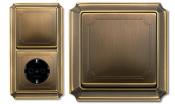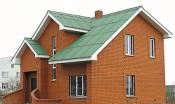Search
Login
DIY blind area at home
The absence of the blind area of \u200b\u200bthe house leads to subsidence of the foundation, increases the humidity of the walls of the house - all this leads to a slow destruction of the structure.
Content
- Task blind area at home video
- Dimensions of the blind area of \u200b\u200bthe house
- Materials and types of blind areas
- The principle of the blind area
- The blind area with geotextiles
- Complicated blind area
- Requirements for waterproofing soft blind area
Task blind area at home
The absence of blind areas is permissible only if the building is built on dry soil without sediment, and the building itself is erected on a columnar foundation.
In all other cases, the blind area is a mandatory attribute of the building.
First of all, the blind area does not allow moisture to seep to the foundation of the house and also does not allow moisture to rise along the walls, thereby. The blind area protects the house from destruction.
Dimensions of the blind area of \u200b\u200bthe house
Each concrete building should be provided with a blind area of \u200b\u200bindividual sizes.
The dimensions of the blind area directly depend on the type of soil and the width of the eaves of the roof.
According to generally accepted standards, the width of the blind area for ordinary soils is 20 cm wider than the cornice, but without fail, the width of the blind area should be at least 60 cm.
And if the soil is subsiding, then the width of the blind area increases and should be at least one meter.
Materials and types of blind areas
The materials and types of blind areas, for each household, can be very diverse: the blind area of \u200b\u200bgravel, concrete, of paving slabs, etc.
The most economical and uncomplicated option of the blind area, you can offer a pie using river pebbles or gravel.
Principle of the device
The device consists in removing the soil to a depth of 40 cm.
At the same time, they dig a trench with a slight slope from the wall.
The bottom of the trench is lined with an approach to the foundation, a roll waterproofing insulator (roofing material).
Next, small river pebbles are poured, and gravel or gravel can be.
Such a blind area can be made with your own hands, while not requiring large financial investments, only physical effort and a shovel for digging a trench.
However, such an elementary design effectively removes water from the foundation.
It should be noted that it is necessary to construct a drainage system, otherwise during rain, water from the roof erodes small stones and the foundation will have to be periodically corrected.
Of course, such a primitive dumping does not really decorate the building, over time the blind area sags and walking on it is not very pleasant.
The blind area with geotextiles
You can offer the blind area with geotextiles - this is a more complicated blind area.
The use of geotextiles makes the blind area more durable, durable, since geotextiles are a permeable synthetic material.
The device consists in installing the same trench, roll waterproofing is laid on the ground, 5 cm of coarse-grained sand is laid on the waterproofing, about 15 cm of geo-textile is laid on top with overlap, 10 cm of gravel are poured on it, then another layer of geotextile and the last layer crushed stone or pebbles up to 10 cm high.
Complicated blind area
A complicated blind area is created in the same way as described above, but instead of pebbles, sand is poured and decorative paving is constructed.
In this case, you can use the paving slabs.
It should be noted that to fix the paving slabs, experienced specialists do not use cement mortar, since after hardening it will necessarily crack.
The tiles are driven in using a rubber mallet, and after laying the tiles, the gaps between the sidewalk tiles are sown with fine dry sand.
Such a blind area looks more aesthetically pleasing, it is convenient to walk on it.
But this blind area has a drawback, since the paving slabs will not be able to dampen the spray of water falling on it, and during the rain the base of the house will get wet.
Tip - to prevent humidification of the base, it is a good idea to finish the base with tiles for external use (porcelain stoneware).
Requirements for waterproofing soft blind area
When choosing waterproofing a soft blind area, it is necessary to pay attention to its durability and frost resistance.
Of course, in a financial sense, a plastic film or roofing material and all bitumen materials are much more economical.
But, all of them are not able to compete with waterproofing materials made of polypropylene.
It is possible to recommend, for the application of the arrangement, blind areas and PVC films.





